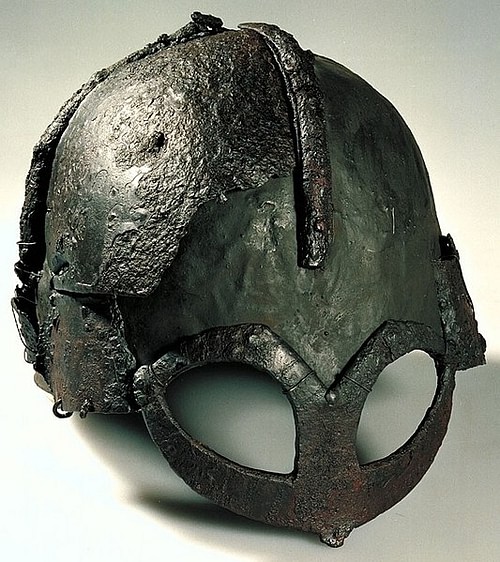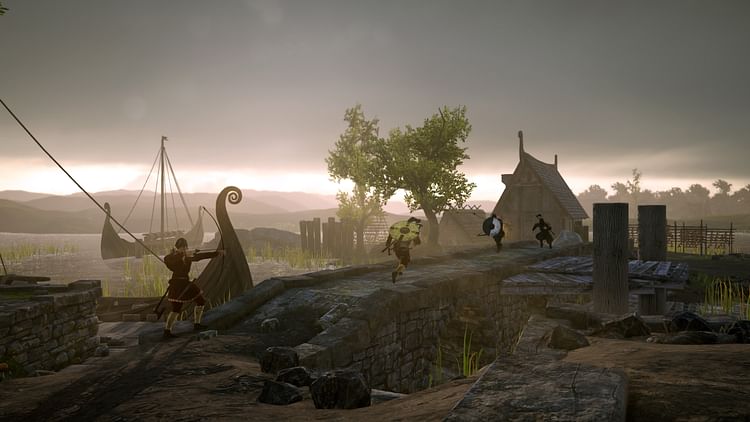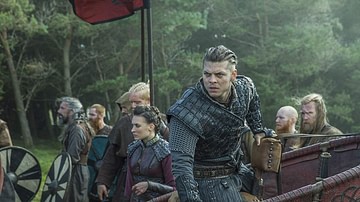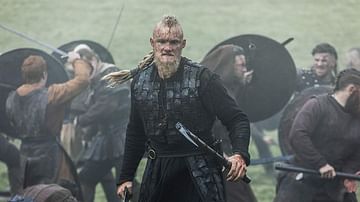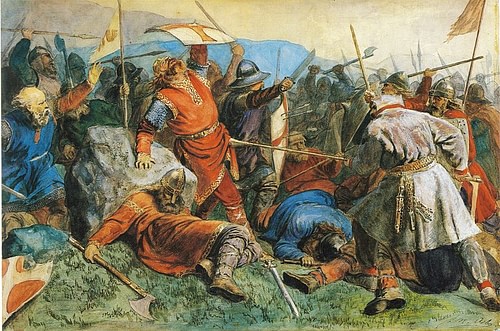
Viking warfare, along with its key component of raiding, is inextricably connected with the expansion of Scandinavian influence along the North Atlantic and into the Mediterranean in the Viking Age (c. 790-1100 CE), where the Vikings' heavy use of ships, good strategic mobility and strong grasp on logistics ensured they could cause havoc abroad for years at a time.
It was these factors that distinguish Viking warfare from that of their contemporaries in Medieval history; despite public imagination (and television) often picturing savage berserk-warriors frothing at the mouth and committing unspeakable brutalities to their unlucky targets, Viking warriors were probably no more brutal than their peers.
Scandinavian society at the time was not made up of unified kingdoms as we know them today; these only crystallised into those forms towards the end of the Viking Age. Despite the word 'Viking' (Old Norse víkingr) now often being used as an umbrella term, the original meaning of the term is specifically 'raider' or 'pirate', and fara i víking ('to go on expedition') related not to harmless adventures but to armed raids of warriors who unleashed their swords and axes upon profitable objectives abroad. The lion's share of these raids was undertaken by individual warbands that might team up when needed and whose leadership ranged from small, local chieftains to earls and kings. The Vikings' characteristic hit-and-run tactics were bolstered by the establishment of overwintering bases, from which campaigns could be launched and more land could be conquered, leading to the establishment of several full-fledged Viking territories far from the Scandinavian heartlands.
Weapons & Armour
With regard to weaponry and armour, we are heavily reliant on the archaeological record as there is not much in the way of technical descriptions to be found in the sources. Fighters in Viking Age Scandinavia used the following weapons and armour:
- swords (both single- and double-edged)
- axes and battle axes
- daggers (or a short-sword/sax/seax as common among Germanic peoples around this time)
- spears
- bows and arrows
- shields
- helmets
- mail shirts.
With Viking warbands hailing from all sorts of different regions across Scandinavia, there are general trends but obviously loads of regional variation and nothing like a standard outfit.
Viking swords were made of iron blades, intended to be held in one hand, with broad grooves along the centre ('fullers') cutting down their weight a bit. Double-edged swords coming in at around 90 cm in length seem to have been the preferred standard. They could be beautifully decorated with geometric patterns, motifs of animals or, in the Late Viking Age, even Christian symbols, in silver and/or copper inlay. A wooden scabbard finished off the set. Because swords were the most pricey weapons around at the time they were not in every warrior's financial reach; their owners would have been wealthy warriors who made a bit of a statement. Some Viking sword blades, such as the Ulfberht swords, were made from a homogeneous steel of a quality that rivals early modern steel-making.
The one-handed Viking axe was not only a everyday utility tool, but also a common weapon in Norse society and were the primary weapon of many warriors. Axes were known mostly from finds of numerous axe-heads (as the wooden shaft was not preserved) that appeared not only in richer graves alongside other weapons but also as the sole weapon in more austere burials, indicating that, unlike swords, axes were a common tool and may have been used across a broader economic spectrum. A short-sword or dagger, also called sax or seax following the Saxon example, could get its owner out of a pinch in close-quarter combat or as a backup weapon. Other Viking weapons include heavy trusting spears or lances crafted from iron and sporting leaf-shaped spear heads, their shafts most likely up to 2 meters long, and bows and arrows. Interestingly, the literature also alludes to the possible use by Scandinavians of some sort of siege engines, although their wooden remains would have long since turned to dust and we can but guess at their precise design and use.
Shields were part of the standard kit; laws even stated ship's crewmembers were all required to carry shields. Made of wood and circular in shape, they were probably covered by leather, too, and came in a variety of distinguishing colours. Chain-mail shirts made of interlinked iron rings are known but rare - possibly too expensive to be worn by just any fighter - and although leather may have been used instead, it is hard to tell exactly how common leather armour was. Helmets were worn in battle but, contrary to popular depiction, were not horned helmets, as the Vikings did not much fancy getting caught in their opponents' beards or suffering other impractical consequences. The few helmets that have survived show a simple iron design of a conical cap with eye-guards and perhaps a nose-guard and probably a mail sheet dangling off the back to protect the owner's neck. It is probable that similarly structured leather helmets were also (perhaps more commonly) in use.
Raids
As the 8th century CE drew to a close, the first reports of Viking raids trickled in, such as that on the monastery at Lindisfarne off the coast of Northumberland in what is now England in 793 CE or those on the island of Rathlin and Iona near mainland Ireland in 795 CE. These early raids were undertaken on a small scale, seemingly by local groups gathered by local leaders, and focused on vulnerable, exposed targets such as these coastal monasteries or trading centres, not normally heading far inland. Characteristic is the Vikings' hit-and-run strategy, in which they moored their ships on the doorstep of whatever they were attacking, rounded up valuables and the occasional slave, and sailed or rowed off into the distance before any effective defence could be mounted against them.
Viking shallow draught ships were a key element of Viking warfare, not in a sea-battle sort of sense, but because they were extremely fast and light, not only facilitating quick coastal strikes but also allowing them to head up rivers and penetrate inland. This came in use as, by the 830s CE, a general increase in both the size and the frequency of Viking raids is independently reported for Britain, Ireland, as well as western Europe (in particular in Frankish territories). Ramping up the number of ships in their fleets from the earlier handfuls to hundreds, the Vikings now began attacking targets further inland, such as their hits in 834-836 CE on the major trading centre of Dorestad some 80 km from the open sea in what is now the Netherlands. Named kings or earls from the upper levels of Scandinavian society – reflecting personal status at home, but not necessarily rulership of large territories - now crop up as leaders, too, besides the lesser chieftains who would also have remained in the limelight. As Gareth Williams explains:
Occasionally, with the 'great' warbands of the late ninth century we see several kings or earls jointly leading their forces, again implying a merging of smaller independent forces. This apparent lack of formal structure makes their achievements in long-term campaigning and strategic and logistical planning even more impressive. (199)
First in Ireland and then also in England, the Vikings also began to overwinter in hostile territories, taking over or setting up bases. A side effect, however, was that this of course drastically reduced their much-prized mobility, and in Ireland, for instance, this led to them suffering a bunch of defeats. It must be noted, however, that the same pattern – an increase from small-scale to large-scale raiding accompanied by overwintering - did not apply to all Viking-conquered territories. Danish chieftains settled in Frisia early on in the 9th century CE and dealt with the area's Frankish overlordship by juggling political relations with the Franks, and Norse Scotland was extensively settled early on, probably from the start of the 9th century CE.
Combat & Tactics
Like the rest of early medieval warfare in western Europe, Viking warfare could not simply ignore the encumbering effects of winter on campaigning and logistics. As such, it was generally a seasonal affair, with a built-in winter holiday initially back home in Scandinavia but increasingly in overwintering bases and settlements once they popped up in Viking-held territories abroad. From such settlements the Vikings could participate in local politics, tactfully choosing sides, reaching agreements with their enemies, securing the payment of tribute, and launching new campaigns.
Even when it comes to inland battles, the Vikings' beloved ships remained crucial wherever they could be put to use. The ships had a shallow enough draught to paddle up the larger rivers, carrying anything from men to supplies and loot, meaning that whenever the Vikings campaigned near areas their ships could reach they had no need for annoyingly slow overland baggage trains.
Things get hazier, however, regarding the actual specifics of Viking combat in battles:
We know little of specific battle tactics. Those references that we do have suggest that the shield-wall was the most common tactical formation. Archery was probably also used to break up the shield-wall, as it was not an ideal position in which to receive arrows (it provided a large target, with little manoeuvrability), and the longbows known to have existed in this period would have penetrated shields and armour, though not necessarily deeply. (Williams, 28).
Horses, although used for their mobility, were probably dismounted for battle. Battle standards were carried near the leader or leaders, probably to indicate status. Some of these standards depicted ravens, such as the one used by Harald Hardrada at Stamford Bridge (1066 CE) against the Anglo-Saxons. Although shouting matches may have sufficed regarding communication in smaller skirmishes, one can of course only shout so loudly; animal horns may also have been used to bellow out signals and pick up the slack. For conveying more articulate orders and information, it is likely messengers would have zoomed across the battlefield at high speed.
One Viking force where such communicative measures would have been invaluable is that of the Danish 'great army' that razed havoc across England from 865 CE on, campaigning for years and bringing the kingdoms of East Anglia and Northumbria as well as most of Mercia to their knees. Even Wessex, under its leader King Alfred (r. 871-99 CE), struggled to resist the Viking forces but eventually won a decisive victory. The Vikings' great army disbanded c. 880 CE, its warbands seemingly jumping to take advantage of a succession struggle in the Kingdom of the Franks where they were active between 879-891 CE. Flexibility and keen opportunism were key.
Organisation
A large army would have been composed of several warbands, although we only know little about the precise organisation or command structure. Local kings, earls, and chieftains may all have led individual portions of the army, holding specific command roles and probably following some sort of hierarchic order. At the Battle of Ashdown (871 CE) where King Alfred beat the great Danish army, one of the Danish wings was led by two kings while the other was captained by 'many jarls' (Williams, 19), for example. As the Scandinavian kingdoms began to take on more unified shapes, bigwig kings such as the Danish King Sweyn Forkbeard (r. 986-1014 CE) were probably responsible for a more tightly-knit hierarchy, in which they themselves commanded the crews of several ships, supplemented by their main chieftains' personal forces. The total numbers of warriors then easily reached into the thousands in time of conflict.
Connections between the various kinds of leaders, and between them and their crews, could have taken the shape of kinship or personal ties, social ties, or could be loot- or tribute-driven. There probably was no such thing as a systematic levy for Viking fleets. Although the term leiðangr indicated a force directly under control of the king (and in this capacity it may have sporadically been used during the Viking Age), the specific levy connection is only known from sources dating to the mid-12th century CE and beyond. Instead, Viking Age ventures were likely mainly private affairs.
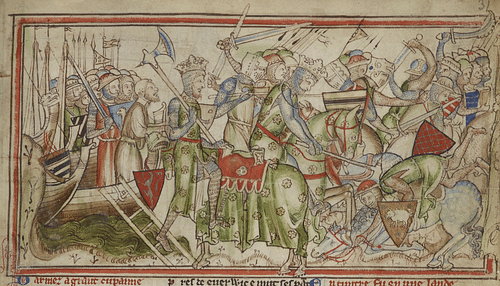
It has been argued that the units in battle could have had their origins in the crews of ships, which sounds logical enough considering the Vikings' heavy reliance on ships and the sense of companionship that would have grown from helping each other deal with the occasional seasickness. As for the raiders and warriors themselves, they were generally young men – as per both the sagas and the skeletal remains that have been found. None of these as of yet definitively prove the existence of female Viking warriors. One can imagine more experienced warriors being invaluable, too, though, bringing some stability and knowledge with them. Indeed, accounts detailing the Vikings' years-long campaigns in the late 9th century CE paint a picture of adolescents or young adults joining up and remaining active into their thirties and even beyond. Interestingly, evidence has shown that troops may also have been partially drawn from areas outside of Scandinavia; a southern Baltic connection is attested to with regard to garrisons in Denmark, and even the Scandinavian forces active in England in the 10th century CE were a mishmash rather than reflecting any kind of 'national' army.
Distinctive Features
Despite it appearing as such, Viking warfare is actually not such a huge anomaly on the early medieval European landscape. Besides the fact that technologically the playfield was fairly level, raiding with the objective of plunder was hardly an exclusively Viking affair; in fact, it was even typical of pre-Viking Ireland and Britain and was widespread throughout medieval Europe in general. Tribute-taking also occurred outside Viking spheres throughout Medieval history, even being central to relations between kings in early medieval Britain.
Ships were also used by both the Anglo-Saxons and the Franks, however, both the Vikings' specific naval technology – building faster, seaworthy ships with shallow draughts, perfect for lightning-strike hits and also cargo-types – and the way they put their ships to use in their archetypal hit-and-run raids is a highly distinguishing factor. Other key elements that tie in with this are a strong focus on strategic mobility – ships supplemented by the use of horses on land; good logistic awareness and capabilities allowing for good supplying on campaign; good military intelligence and a nose for picking vulnerable targets, as well as responding quickly to changing situations; and their fluid structure of individual warbands led by private leaders. Perhaps most importantly, though, overwintering stands out. The bases built or taken over in this context became supreme rallying points from which to spread out across the surrounding area.
For those looking to withstand this combination, direct battle against the Vikings was usually more of a band-aid, as was the payment of tribute that could buy peace for a while. Gareth Williams explains that "it was only when the twin issues of mobility and supply were tackled that the Viking raids could successfully be contained" (198). Fortified bridges were used by Charles the Bald, King of West Francia (r. 843–877 CE) to block the Vikings' access to the rivers and also by Alfred the Great of Wessex (r. 871-899 CE), whose simultaneous ship-led coastal defence and building of fortified towns (burhs) across Wessex eventually halted the Vikings there.
A Lasting Reputation
Aided by the swords and ships, Scandinavians in the Viking Age greatly extended their influence from the North Atlantic to the Mediterranean and even as far as Constantinople, where some Norsemen decided to become professional warriors in the emperor's employ, such as the Varangian Guard. Both the tendency within the contemporary accounts and, for a large part, their present-day image (especially in popular culture) leads one to believe that during this time the European seas and rivers were positively teeming with Viking-shaped pirates. Viking warriors are often depicted as savage and brutal and, importantly, heathen, showing no quarter to their unfortunate prey and being disproportionally successful on the battlefield. However, this characterisation is not only pulled out of context but also exaggerated or even wrong.
Contemporary accounts were often penned by monks – indeed, people in the first line of fire when it comes to Viking raids plundering monasteries and the likes – or by other targets. It is thus hardly surprising they did not sing the Vikings' praises. They were outraged at the fact that these heathens attacked churches and slew churchmen, even though we know Christian rulers sometimes attacked churches, too. Especially in the early raiding years, moreover, Viking raids were only sporadic affairs and hardly brought local institutions tumbling down, and others also raided. Furthermore, although they were brutal by modern standards, the Vikings were hardly out of place in early medieval Europe whose other inhabitants needed absolutely no tips from the Vikings.

